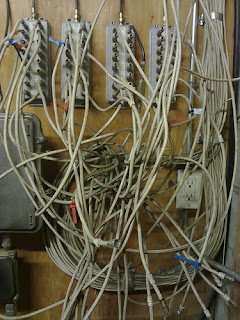Internet Resellers
TekSavvy talk has been making the rounds lately on forums at work and online. They're in the news among the other victims of the ongoing CRTC ruling on the "usage based billing" or wholesale billing regulations from large ISPs to small ISPs. I decided to take a look at what folks were talking about - really cheap rates for high speed internet, long distance calling, residential phone and even cable at much lower rates than the standard Bell or Rogers! However the ruling will make unlimited packages impossible or too expensive, as the cost of using Bell or Internet backbone services is transferred to the consumer, say for example Bell will charge TekSavvy or Acanac an extra $22/ Mbit or 22k for 1 Gbps link. The other thing is I didn't quite understand right away, why when the TekSavvy customers had a problem and they called up TekSavvy tech support, a service call would be sent out to Bell or Rogers. Ok I get it, Bell or Rogers still provide the DSL or last mile connection. TekSavvy is an "internet reseller" or ISP.
There is a business arguement for open competition that folks are feeling very strongly about for Open Media debate and a petition. My article is purely about the electrons not the politics. Back to the basics.
 |
| Image Source |
The story begins with the telephone cabling we are already familiar with. It's copper and can carry 300 Hz to 1 MHz of data. However the human voice is only using the 300Hz to 3 kHz portion of the link, DSL can use the remainder 3 kHz to 1 MHz for high speed data, "always on". DSL stands for Digital Subscriber Line, and this allows the packets to be sent over copper, owned by an ISP. It is not a shared medium, each user has his own direct connection to the DSLAM. It's scalable, adding new users does not impede the network performance. DSL can be used simultaneously as voice.
The cabling part there is also refered to as the local-loop or last-mile or the last step of the local telephone network connection. DSL may be added incrementally in any area with some distance limitations, but is not universally available everywhere in all geographic locations. Equipment required includes the CPE (Customer Premise Equipment) and DSL-Access Multiplexer (Time Division Multiplexer). There is a physical geographic limitation of 5.5km distance for ASDL, and some folks would consider the "always on" aspect of the DLS as hackable; well whatever.
DSL can be used by a large company to support the "work at home" workers. The worker cannot connect to the enterprise network directly; instead he first connects to the ISP and then an IP connection is made from the Internet to the enterprise network.
There are two categories of DSL
DSL places the data upload and download above the 4kHz window, allowing voice and data transmission to occur simulataneously on the same DSL service.
ADSL Asychronous, higher download bandwidth than upload (less than 5.5 km distance)
VDSL, VDSL 2 is very high data rate
250 Mbps at the source
100 Mbps at 0.5km
500 Mbps at 1km
G Lite, G 992.2
ADSL, ADSL2, ADSL 2+
Consumer DSL aka G.Lite or G992.2
SDSL Synchronous, same capacity both directions
HDSL high data rate DSL
ISDN DSL(IDSL)
G.shdsl, symmetric high bit data rate DSL
In all instances, it's WAN access. It is not cable; cable is best described as a bus network topology, fiber under the street, copper to the home. (Why do I have this in my notes?)
Transceiver - connects the computer of the worker to the DSL, usually a modem with USB or Ethernet cable. Newer DSL transceiver can be installed on routers with 10/100 switch ports for home and office use.
DSLAM - located at Central Office of the carrier. DSLAM combines individual DSL connections into one high capacity link to the ISP and Internet.
Assigning an IP Address
Used to be that when you turned on your computer the ISP would assign an IP address to your computer by DHCP, and then when you were finished with your connection the computer would return the IP address to the pool. The only thing is, people don't usually turn off the computer so this IP address will almost permanently taken. I suppose if it was a work computer, the network administrator could use Private and Public IP addresses translation.
The global internet is like a large WAN. Servers need an IP address from the ISP and interfaces - which are manualy assigned by the ISP or dynamically assigned. When you have private IP address and need to go on line. The IP addresses will have to be translated by NAT from an Internal lab to the outside world.
Next Topic:
NAT, PAT and Overloading
Good blog, this has helped me a get started on studying DSL. I failed my ICND1 yesterday as I had a mighty 5 or 6 questions on it... I hadn't studied any DSL at all!
ReplyDeleteThanks for writing. I haven't posted in a while as I wrote the ICND1 in April and I haven't studied enough for the ICND2. Good luck!
ReplyDelete